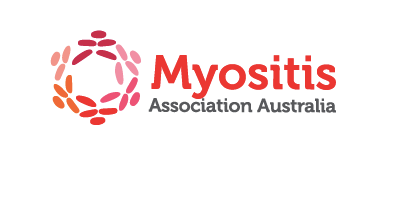What is Antisynthetase Syndrome?
Some people with Dermatomyositis or Polymyositis may also have a further complication, Antisynthetase Syndrome. People with this syndrome have antisynthetase autoantibodies that attack a particular protein essential for our muscles to function well.
There are eight different types of antisynthetase antibodies relevant to the ASyS form of Myositis that have been discovered to date. The most common being anti-Jo-1, followed by anti-PL-7 and anti-PL-12. Blood tests can be used to identify the presence of antisynthetase antibodies.
People with Antisynthetase Syndrome have a higher risk of developing interstitial lung disease (ILD).
Antisynthetase Syndrome is more common in women than in men.
Signs and Symptoms
Some of the signs, symptoms and complications of Antisynthetase Syndrome include:
- Muscle inflammation, pain and stiffness
- Higher risk for interstitial lung disease (ILD)
- Nonerosive arthritis
- Mechanic’s hands – a roughening and cracking of the skin of the tips and sides of the fingers
- Hiker’s feet – a roughening and cracking of the skin of the toes and soles of the feet
- Fever
- Fatigue
- Loss of appetite or unintended weight loss
- Raynaud’s phenomenon – temporary disruption of blood flow to the small blood vessels in extremities. In response to cold or stress, your fingers, toes, tip of the nose, lips and ears can turn blue, feel cold and numb. After the blood flow returns, you may feel tingling and throbbing in the affected areas.
Not everyone has all of the signs and symptoms above as they tend to vary from person to person.
What causes Antisynthetase Syndrome?
The cause of Antisynthetase Syndrome is not fully understood. It is thought that it may start in the lungs of people who are genetically predisposed after being triggered by infections or exposure to certain environmental factors (eg. airborne contaminants).
How is Antisynthetase Syndrome diagnosed?
Some of the tests for diagnosing Antisynthetase Syndrome include:
- Medical history and physical examination: The diagnostic process is started with a careful look at your medical history and a thorough physical exam
- Blood tests can be used to identify the presence of Myositis-specific antisynthetase antibodies. The most common antisynthetase antibody is anti-Jo-1, followed by anti-PL-7 and anti-PL-12.
Blood tests can also be used to identify if there are higher than normal amounts of muscle enzymes (creatine phosphokinase or aldolase) circulating in the bloodstream that indicate muscle damage. - Scans: High-resolution computed tomography (HRCT) is used to detect lung disease. People with Antisynthetase Syndrome have ahigher risk of developing interstitial lung disease
- Electromyography: A test where wires are attached to the skin to measure the electrical activity of muscles
- Other tests: Pulmonary function tests may be done to determine how well the lungs are working.
How is Antisynthetase Syndrome treated?
Due to the condition’s rarity, there are currently no standard treatment protocols or guidelines. As such, treatment tends to be focused on the symptoms unique to each person. This includes whether they have symptoms of interstitial lung disease and, if so, the severity of these symptoms.
In general, Antisynthetase Syndrome treatment is often based on corticosteroids and/or other immunosuppressants.
Physiotherapy is recommended to help increase muscle strength.
Follow up for interstitial lung disease may include pulmonary function tests and HRCT imaging.
What research is being done?
Research is ongoing to learn more about Antisynthetase Syndrome and test potential treatments. There are a number of studies related to antisynthetase syndrome that are currently recruiting participants. More details can be found on the clinicaltrials.gov website.
Stay up to date
Research is moving forward at a fast pace, so this research summary may not be up-to-date at the time of reading. One of the best ways to stay up to date with the latest on research is to become a member. We regularly provide updates on research in our bi-monthly member newsletters.
